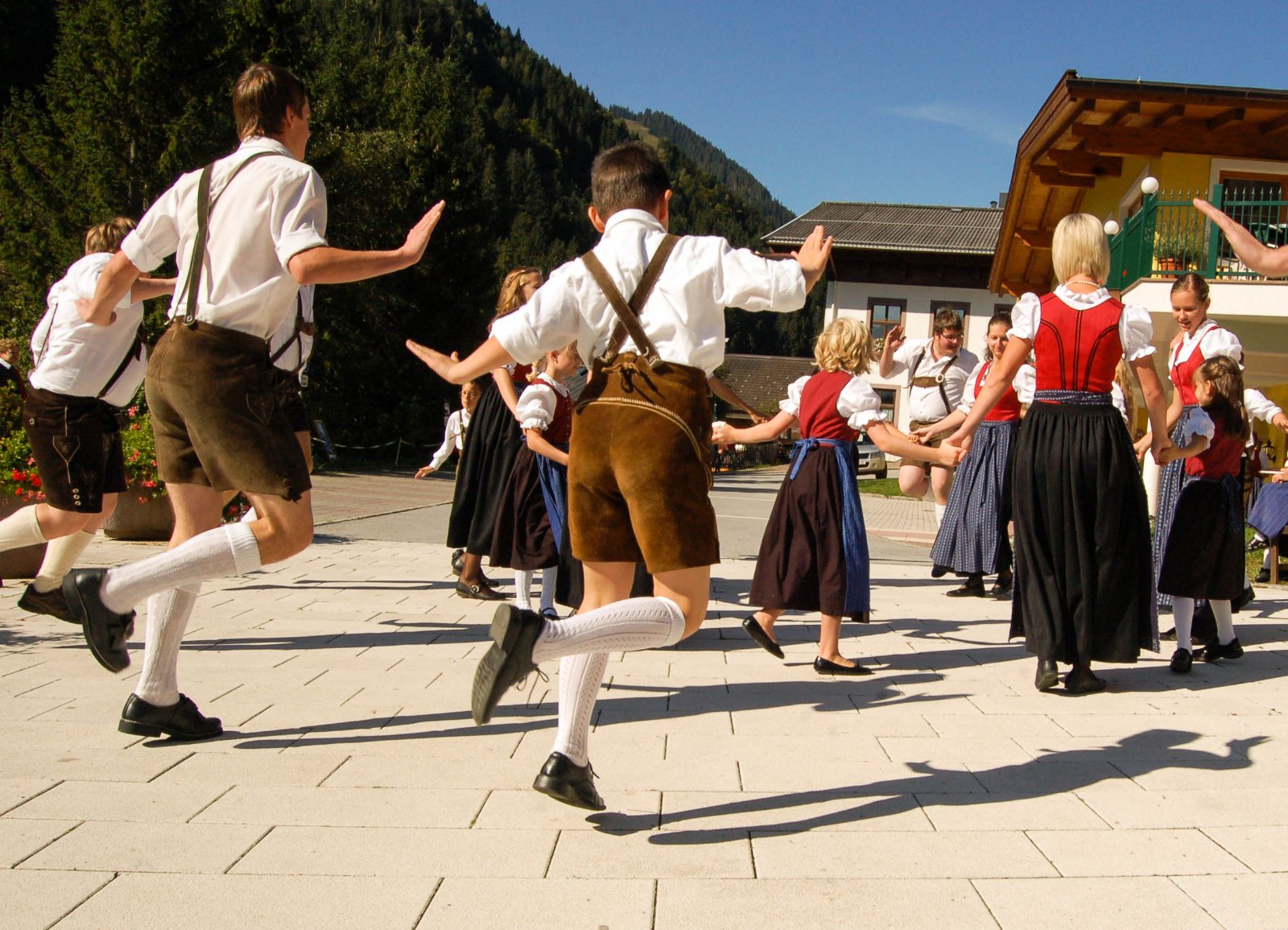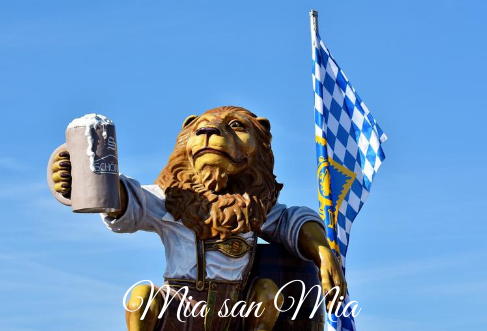At tent festivals , at church days, at folklore events and village festivals : the Schuhplattler should not be missing and cut a fine figure at every opportunity. They jump, clatter, clap, whoop, turn in circles and loudly draw attention to themselves.
AHA! cool...
Strictly speaking, the Schuhplatteln is a traditional dance that is mainly cultivated in Bavaria and Austria . The dancers rhythmically hit the floor and their shoes with their hands and feet . Here are some important stations of the Schuhplatteln:
- The march in : The dancers march in their traditional costumes in a specific formation onto the stage or the square where the Schuhplatteln takes place.
- The beater: A beater sets the pace and plays a percussion instrument such as an accordion , a guitar or a Styrian harmonica.
- The Dance: The dancers show different figures and step sequences, which are often very acrobatic . They rhythmically hit the ground and their shoes with their hands and feet.
- The groups : The Schuhplatteln is often performed in groups consisting of four to twelve dancers . Each group has its own sequence of steps and figures.
- The music : Traditional folk music is often played at Schuhplatteln. The pieces of music are often very rhythmic and are good for dancing.
- Clothing : The dancers wear traditional costumes , which are often very elaborately designed. The costumes differ depending on the region and can also be very different within a region.
- The competitions : There are also Schuhplattler competitions where the groups demonstrate their skills and are judged by a jury. Not only the sequence of steps , but also the clothes and the charisma of the dancers are evaluated.
- Passing on the tradition : Schuhplatteln is often passed on and maintained from generation to generation . Many regions have their own Schuhplattler clubs that regularly organize performances and events to keep the tradition alive .

Schuhplattler in action
Origin
The name Schuhplattler is proven to come from around the middle of the 19th century , but was first mentioned in a similar form in 1050 by a monk from the Tegernsee monastery in the knightly poem "Ruodlieb" . It describes a village dance , with the description of the jump and hand gestures in the dance pointing to the early form of the Schuhplattler.
Another version holds that the origin of Schuhplatteln evolved from an original work dance in which dancers would stomp on the floor to clean their shoes. Over time, more and more complex sequences of steps and acrobatic figures were added to the dance.
During the time of National Socialism, the Schuhplatteln was instrumentalized as part of national culture and promoted as a symbol of German folk culture. After the Second World War, the Schuhplatteln was increasingly cultivated as an expression of regional culture and helped to create awareness of the cultural diversity within Germany and Austria. In the 1970s, Schuhplatteln also became known outside of Bavaria and Austria and experienced a renaissance as an expression of traditional culture.
The Schuhplattler is undoubtedly one of the most distinctive Bavarian forms of expression . The word Schuhplattler is derived from the dance style, as the dancer slaps the shoes (more correctly the soles) with his hands . Its inventors were the common people: farmers, hunters and woodcutters who created this expressive dance based on the courtship behavior of the capercaillie and wanted to woo their "deandl".
In earlier centuries, the Schuhplattler was a classic courtship dance : the dancers showed their acrobatic skills with hopping, turning and platters and wanted to win over the dancers. Take, for example, the simple woodworker of his time, whose (working) power was his pride and wanting to demonstrate this power. It was necessary to demonstrate a balanced mixture of musicality, body control, speed and dancing precision .
history
When the Empress of Russia was staying in Wildbad Kreuth for a cure in 1838, the locals honored her with a dance performance that came very close to the Schuhplattler. During the dance, the boy was free to move to the Landler melody , show figures, jump and platter, while his dirndl continued to turn to the beat and was only caught up by him when he was dancing around.
On July 15, 1858, a Schuhplattler was performed in the Oberland on the occasion of a journey by King Max II through the Bavarian mountains. In 1861, a “ Gemütlichkeitsverein ” was founded in Miesbach for the purpose of Schuhplattler, which was renamed the Schuhplattler-Gesellschaft in 1866. In general, wherever the Schuhplattler is cultivated or can be seen, it is directly associated with Bavarian customs and the original joie de vivre .
In the rural areas of Tyrol and Upper Bavaria, musicality, rhythm and one's own urge to move were freely followed. The basic form is the Landler , which came to Bavaria from Austria at the beginning of the 18th century. After the Congress of Vienna (1815), the Schuhplattler became more and more popular.
Characters vary from location to location and new ones are added.
In the end, some boys in the Bavarian Oberland discovered how popular the Schuhplattler was . The meaning of the Schuhplattler slowly changed from a courtship dance to a show dance .
Unbelievable
World record for the Guinness book
The world record in Schuhplatteln is back in Bavaria. To be more precise, to Antdorf , a community in the Weilheim-Schongau district south of the Osterseen. On Father's Day 2019, 1312 Trachtler made their way into the Guinness Book of Records and stole the existing record of 1296 Trachtler from the Austrians back to Bavaria.
Schuhplatteln has also absorbed influences from other dance forms such as tap dance and flamenco . It was also taken up by well-known artists and musicians, such as Johann Strauss in his work " Unter Donner und Blitz". In the meantime, the Schuhplatteln has also been recognized as an intangible cultural heritage by UNESCO and is maintained and passed on by many organizations and associations to ensure that it is preserved for future generations.
What's exciting to see
Schuhplattler as a show act at events
The popular Bavarian form of expression is particularly characterized by the slapping of thighs and shoes to the Landler melody.
There are regional differences in this traditional dance from Lower Bavaria to East Tyrol, as well as various dances such as Schlogplattler, Marschplattler, Holzhacker or Bankerltanz.
Schuhplatteln is a show dance that international guests enthusiastically film as a show act at events such as the Harvest Festival in Vienna.

Schuhplattler of the group Voigasplattler Source: Voigasplattler
Regional differences
There are around 150 different Schuhplattler dances and in the area between Königsee in the east and Lake Constance in the west, between the Danube in the north and the Tyrolean border in the south, where the Schuhplattler is native, there are still differences in landscape.
In south-eastern Upper Bavaria , for example from Rosenheim to Bad Reichenhall, the exact, strict Schuhplattler with a loud hit and an upright posture is more common. In the Oberland and the rest of southern Bavaria, on the other hand, it is more the cozy Schuhplatteln on the heel and with rounder, looser strokes at home.
For quite a few peoples, the traditional dance combines the attributes described in an almost ideal way. South American enthusiasm is commonly equated with "Samba" du "Pasa Doble", Greek hospitality with "Sirtaki" and Hungarian temperament with "Czardasz".
